Technology Vision
Seamless Connectivity Service and Mobile Optionality: A New Era of Innovation

Key Points
- CableLabs is advancing broadband innovation with two new initiatives — Seamless Connectivity Service and Mobile Optionality — that are designed to move networks from speed-focused to adaptive, intelligent systems.
- Together, they position CableLabs member operators to deliver smarter, more resilient broadband experiences for their customers.
- CableLabs members are invited to register for a live webinar on Thursday, Oct. 30, to learn how these initiatives can revolutionize the connectivity experiences of their subscribers.
The broadband industry is evolving. Speed is no longer the only measure of value — users now expect connectivity that is seamless, secure, responsive and adaptive. CableLabs is leading this transformation through its Technology Vision and Eras of Broadband Innovation, which illustrate the network’s evolution from raw speed to intelligent, adaptive services.
To realize this vision, the industry must deliver practical solutions that leverage today’s infrastructure while paving the way for tomorrow’s innovations. Two new CableLabs initiatives — Seamless Connectivity Service (SCS) and Mobile Optionality (MO) — are doing just that.
Seamless Connectivity Service: Connectivity That Just Works
Imagine a world where you never have to think about your network connection — at home, at work or on the go. That’s the promise of Seamless Connectivity Service. This groundbreaking concept enables subscribers to enjoy a single connectivity experience across all access types — Wi-Fi, cellular, fiber, satellite or fixed wireless — without manually switching networks or managing multiple services.
SCS makes connectivity simple and transparent, ensuring applications perform reliably wherever users are. By unifying access technologies under one service, operators can deliver best-in-class reliability, security and performance — all while strengthening customer loyalty and unlocking new revenue opportunities.
What Makes SCS Unique
- Seamless Experience: Always-on connectivity across all devices and locations with no user action required.
- Integrated Security: Consistent protection and automatic failover across all network types.
- User Satisfaction: A truly effortless “it just works” experience for subscribers.
Mobile Optionality: Smarter, More Efficient Mobile Networks
While SCS redefines user experience, Mobile Optionality reimagines how operators build and scale mobile networks. By using existing hybrid fiber coax (HFC) infrastructure and unused spectrum above 2–3 GHz, MO supports 5G New Radio (NR) distribution efficiently and affordably.
With MO, operators can deploy 5G solutions that transmit over their HFC networks — achieving greater mobile densification at lower cost than traditional methods. The result is a stronger mobile experience and a competitive advantage in an increasingly crowded market.
What Sets MO Apart
- Enhanced Mobile Experience: Improved mobile performance and coverage with lower deployment costs.
- Service Differentiation: Ability for operators to deliver unique, value-driven mobile services.
- Smart Spectrum Use: Maximizing scarce spectrum resources through dense spatial reuse.
A Unified Future of Connectivity
Together, SCS and MO lay the foundation for a unified, intelligent network ecosystem. SCS simplifies and automates connectivity through unified provisioning, intelligent routing and seamless network handoffs. MO enhances this foundation by extending mobile reach and performance through innovative 5G integration with existing HFC networks.
The combination creates a reliable, adaptive connectivity fabric that moves effortlessly with users — from their living rooms to the open road.
Join CableLabs in Transforming Connectivity
CableLabs is leading the next era of broadband innovation — where seamless, intelligent networks adapt in real time to users’ needs. We invite members and vendors to collaborate with us on Seamless Connectivity Service and Mobile Optionality initiatives.
Join our CableLabs members-only webinar on Thursday, Oct. 30, to learn more about this revolutionary, industry-first offering and how it enables operators to launch new, differentiated services with strong revenue growth potential.
Register for the webinar, and learn more about joining our working groups.
Security
Addressing Emerging Cryptographic Threats in the Age of Quantum Computing

Key Points
- Threats against cryptography are evolving; among them, the threat of quantum computing is increasingly putting critical infrastructure and the data that traverses it at risk.
- Enabling cryptographic agility and leveraging it to migrate to quantum-safe cryptography are approaches that can mitigate these emerging threats.
- Through CableLabs’ Future of Cryptography Working Group, we collaborate with operators and vendors to help the industry navigate the migration to new cryptographic paradigms.
Cryptography is a foundational security technology used to protect digital information by providing the underpinnings for confidentiality, authentication and integrity. Today’s cryptographic algorithms may soon be undermined by emerging attacks, including the realization of a cryptographically relevant quantum computer (CRQC). Such attacks pose a very real and increasingly urgent threat across virtually all industries and their technologies, including broadband network infrastructure.
With cryptography and public key infrastructure being foundational to the security of cable networks, the broadband industry is uniquely positioned to rise to this challenge and seize the opportunity to future-proof networks to be robust, flexible and responsive to any cryptographic threat — quantum or otherwise. In this blog, we’ll review the threats against cryptography on the horizon, the solution to mitigate those threats and actions to start migration to new cryptographic paradigms. Many organizations, including network operators, have started taking action to plan for and execute cryptographic migrations.
The Threat: Attacks Against Cryptography
So, what exactly is the risk? To put it simply, quantum computers will one day be powerful enough to crack the asymmetric cryptography that is the basis of confidentiality, authenticity and integrity of data at all layers for virtually all devices deployed today. The current timeline for the potential development of a CRQC is 10–30 years — with increasing probability. That estimate isn’t certain, and recent research advancements suggest that it could be sooner.
While that time frame is wide, the risk of compromise is relevant today, thanks to the “harvest now, decrypt later” style of attack. In this scenario, adversaries may capture encrypted data today and retain it, planning to decrypt it once they have access to a CRQC. Any sensitive data generated today that will remain sensitive in the future (such as health records) is therefore at risk today.
The Solution: Cryptographic Agility and Post-Quantum Cryptography
So, how can the industry future-proof itself against these threats? The solution is twofold:
- Enabling cryptographic agility: Cryptographic agility is the ability to switch cryptographic systems quickly and efficiently. It’s a forward-looking design principle and capability that helps security interfaces stay flexible and adaptable in the face of all future threats.
- Post-quantum cryptography (PQC): Also called quantum-safe cryptography, these new encryption algorithms are designed to resist attacks from quantum computers. Their standardization, primarily driven by the National Institute of Standards and Technology in the United States, is a global effort that’s been ongoing for the last decade.
PQC aims to be the replacement for today’s vulnerable cryptography. Cryptographic agility is the framework by which systems will be migrated to PQC (and future iterations of cryptographic algorithms). Together, these strategies offer a path forward.
Migrating to PQC and Leveraging Existing Guidance
From existing guidance on cryptographic migrations, the CableLabs Future of Cryptography Working Group — a collaborative initiative bringing together operators, vendors and security experts to prepare for and to navigate changes to evolving cryptography — has identified certain “no-regret” actions, which can benefit network security posture regardless of whether or when the threat of a CRQC is realized. Some of these no-regret actions include:
- Establishing a cryptographic inventory: A comprehensive inventory of what cryptography is deployed is a critical artifact for any organization to compile as a first step towards cryptographic migrations.
- Assessing and estimating cryptographic agility enablement: Cryptographic agility is a deceptively simple concept; effectively enabling it begins with quantifying how cryptographically agile security interfaces are today. Tools exist today to aid in that effort.
- Discussions with vendors: Vendors play a critical role in cryptographic migrations, providing the implementation of security interfaces and concretely enabling cryptographic agility. Therefore, early and ongoing engagement with vendors on their roadmaps for enabling cryptographic agility and migrations to new cryptographic paradigms is key.
- Risk assessments and defining risk tolerance: Migration of cryptography at full organization scale is an optimization problem; undertaking risk assessment activities to identify the devices, services and interfaces that are at highest risk and should be prioritized for migration is crucial.
Taking Action Through Collaboration
Over the next decade, regulatory bodies around the world expect critical infrastructure — including broadband networks — to adopt quantum-safe cryptography. That makes the next five years crucial for operators looking to future-proof their networks and enable cryptographic agility as a key security capability. Reaching that goal will require deep collaboration, not just between network operators, but across the entire ecosystem of equipment manufacturers, software developers and standards organizations.
To ensure a smoother transition, the CableLabs Future of Cryptography Working Group is continuing to drive the foundational work to adapt current crypto migration and agility guidance to cable networks, identifying gaps therein and developing strategies to address those gaps. The working group’s mission is to develop practical, industry-specific guidance for enabling cryptographic agility as a new capability and migrating operator networks to post-quantum cryptography.
The threat may be complex, but the goal for the cable broadband industry is simple: Keep our networks — and the people who rely on them — secure for the future. To learn more or if you’re interested in contributing, the Future of Cryptography Working Group is open to CableLabs members and our vendor community. Join us here.
Security
The Malicious Economy: What Happens If Your Defenses Are Insufficient?

Key Points
- Law enforcement is dedicating greater attention to incident reporting and active threat monitoring, an encouraging trend in the fight against ransomware. Still, threat actors continue to evolve their tactics, leading to rising numbers of victims and ransomware variants.
- CableLabs collaborates with several cybersecurity organizations, including M3AAWG, with which we helped develop and maintain best practices for responding to ransomware attacks.
Ransomware has changed a lot in the past few years. The term refers to a form of malicious software loaded by attackers to restrict access to files and other data with the intention of extracting payment from the owners of that data.
CableLabs has been working to make sure that residential and business subscribers have the tools they need not only for preparedness and prevention, but also in the event that ransomware actors target them.
Let’s take a look at how the ransomware landscape has evolved, how law enforcement has changed its approach and how one important document can alter the course of your network’s future.
The Law Enforcement Front
The global climate on the regulatory, legislative and law enforcement front has changed, as you can see in the table below.
|
Technical Developments
|
Policy Involvement
|
|
Threat Actors & Threat Evolution
|
Cyber Insurance Market
|
|
Law Enforcement
|
National Security Implications
|
Evolving Threat Actor Behavior
We’re also seeing changes in threat actor behavior. There’s been a sharp increase in both the number of victims (over 200 percent) and the number of ransomware variants (over 30 percent) in 2025 — a deviation from last year’s trends.
The increased use of ransomware-as-a-service (RaaS), the open availability of threat tools and malicious actor communication all continue to evolve. No longer does the threat actor have to find a way to access systems, they can now buy opened systems and immediately move to the ransom phase. The horizontal disaggregation of the marketplace has enabled more threat actors to engage against more victims, with less technical know-how. Exploited vulnerabilities are now the primary method of malicious access, followed by compromised credentials and email/phishing.
Collaborating to Combat Threat Actors
CableLabs engages with several Information Sharing and Analysis Centers (ISACs) and anti-abuse groups. One of the more focused groups is the Messaging, Malware and Mobile Anti-Abuse Working Group (M3AAWG), where we’re proud to have helped to both originally build (and then shepherd updates to) the “M3AAWG Ransomware Active Attack Response Best Common Practices” document.
We do this work because — although the dogma of cybersecurity defense is to prepare, prepare, prepare — the reality is that no matter how good a network’s defenses are, they can always be stronger.
The Best Common Practices document starts with advice from victims who were previously infected, moves on to steps to follow, lists numerous resources, provides a high-level view of what to expect and finally offers decision guideposts about who to involve and when. The document helps with detection, analysis and response activities; demonstrates how to communicate; and enumerates the deliverables necessary for each stage.
This document doesn’t prescribe specific behaviors, but it helps to make sure the reader is equipped with the right questions to ask, as well as the considered order of approach to tackling a problem.
There will be decisions to make about when to declare an event, whether you have reporting requirement, what law enforcement’s role will be, which disclosures are necessary, whether you pay a ransom (or whether that is legally permissible in your situation), when and how to engage on cybersecurity insurance, and what your potential negotiation options are.
There are always collateral victims in attacks like these, and there may be actions possible or preferable on those fronts that will need to be evaluated. That process is one of many that will involve others within the organization. This document helps lay out who should be considered in each step.
The Importance of Having a Plan
Everyone hopes that this aspect of the global economy will come to a decisive end but, in reality, that’s neither the trend nor the expectation. In a dangerous world, it’s best to have a plan for how your company will act in a multitude of situations — even the unpleasant ones.
The Best Common Practices document is a tool for checking existing policies, technologies and the people involved in the prevention plans, but it can also be a cheat sheet for those who have had to balance other needs against external threats and suddenly find themselves in a difficult situation.
Read the “M3AAWG Ransomware Active Attack Response Best Common Practices” document to learn more about the options that are available for victims of ransomware attacks. The document is one resource in a broader cross-sector toolkit that helps defend against and manage the risk of ransomware threats. For more, check out:
- A Cybersecurity Framework 2.0 Community Profile from the National Institute of Standards and Technology (NIST)
- StopRansomware.gov from CISA
Winston Churchill famously said, “If you’re going through hell, keep going.”
These resources can show you how.
Energy
Driving Efficiency at Scale With TV Set-Top Boxes and Internet Devices

Key Points
- The voluntary agreements continue to deliver measurable energy efficiency improvements in set-top boxes and home networking equipment as shown in the most recent annual reports.
- The U.S. agreements have been extended through 2028, and the network equipment scope is expanded to include Fixed Wireless Access equipment with T-Mobile as a new signatory.
When people think about fighting climate change, they may picture solar panels on rooftops or wind turbines on hillsides. What’s less obvious is the quiet revolution happening inside our homes — through the very devices that connect us to TV and the internet.
Three new reports from the United States and Canada tell a clear story: The everyday set-top boxes and network gear we rely on are getting considerably more efficient, cutting energy usage while keeping pace with our growing digital appetites.
Efficiency Alongside Innovation
The 2024 U.S. Small Network Equipment (SNE) Report shows how internet gateways, routers and modems — the invisible workhorses of the broadband era — are becoming far more efficient. In 2024, nearly 99% of new devices met the latest Tier 3 energy levels, far surpassing the 90% commitment under the industry’s voluntary agreement.
That achievement is striking given what these devices now do. Today’s SNE is expected to support blazing-fast internet speeds, stronger Wi-Fi signals and the growing number of connected gadgets in our homes. Naturally, those features demand more power. Yet the data shows that manufacturers and providers are finding ways to deliver these capabilities without a proportional surge in energy use.
Perhaps the most telling metric is efficiency relative to broadband speed: Since 2015, the average energy use per unit of internet speed delivered has dropped by 89%. In other words, the boxes in our living rooms and home offices are working harder than ever, but they’re doing it more efficiently.
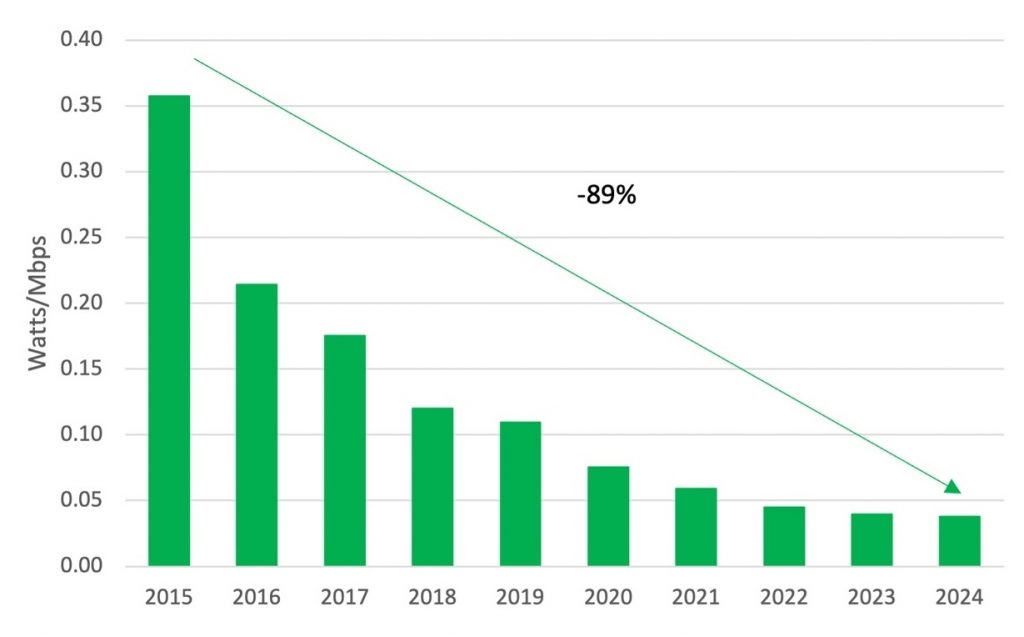
Weighted Average Ready State Power of New SNE Purchases Relative to Broadband Speeds
Set-Top Box Energy Consumption Continues to Improve
If SNE is the silent partner of the digital home, set-top boxes are the more visible face of our entertainment. The 2024 U.S. Set-Top Box (STB) Report paints an equally successful picture. Back in 2012, digital video recorders (DVRs) were notorious power hogs. But as of 2024, the landscape looks radically different.
- National energy use from set-top boxes has dropped 73%, falling from 32 terawatt-hours in 2012 to just 8.6 TWh in 2024.
- That reduction is the equivalent of shutting down eight traditional 500-megawatt power plants for a year.
- It also equates to a $3.85 billion reduction in electricity costs and avoidance of 15.7 million metric tons of CO2 emissions in 2024 compared to 2012.
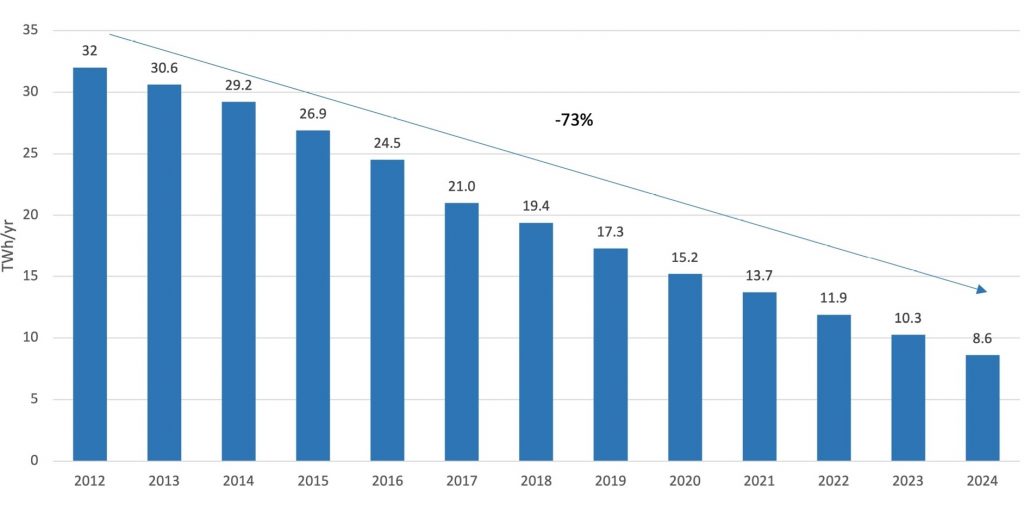
Nationwide Annual Energy Used by Set-Top Boxes in the U.S.
The reasons are twofold. First, service providers are deploying fewer set-top boxes overall, as more households switch to streaming services that don’t require them. But second — and just as importantly — the devices themselves are far more efficient. Today’s most common model, the IP-based non-DVR, uses only 26.6 kWh/year, a 78% drop compared to typical set-top boxes from a decade earlier.
Even DVRs now consume less than half the power they did when the agreement began. And for many households, cloud DVR services eliminate the need for a DVR altogether.
The Trends Continue in Canada Too
In Canada, the Canadian Energy Efficiency Voluntary Agreement (CEEVA) shows steady progress in improving the efficiency of set-top boxes and small network equipment.
According to the most recent 2024 independent annual report, 100% of new set-top boxes and 100% of small network equipment purchased met efficiency targets, surpassing the required 90%. This success reflects ongoing collaboration between service providers and manufacturers to deliver devices that use less energy while supporting modern broadband and TV services.
The data shows meaningful progress:
- Since 2017, the energy consumption of new set-top boxes in Canada has dropped 74%:
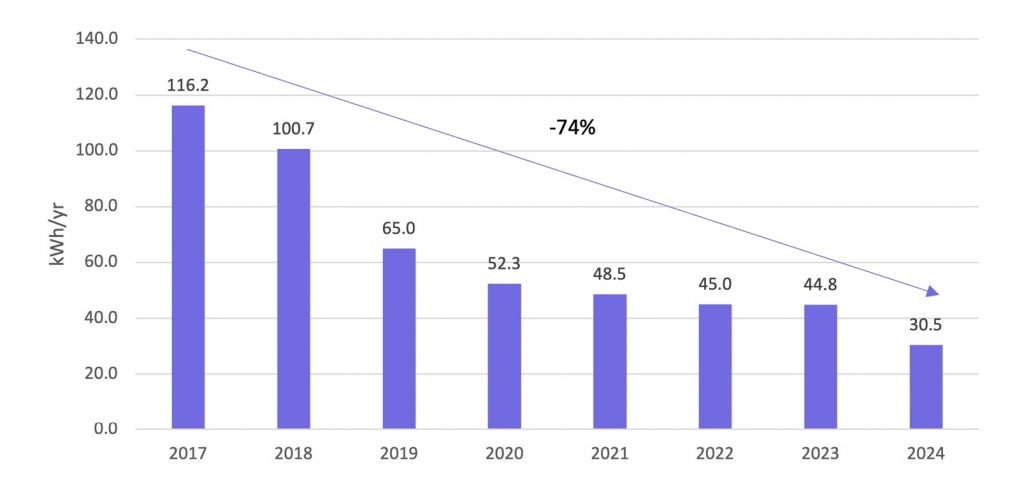
Weighted Average Energy Consumption of Purchased Set-Top Boxes
- Since 2020, the efficiency of small network equipment in Canada has improved 64% relative to broadband speed.
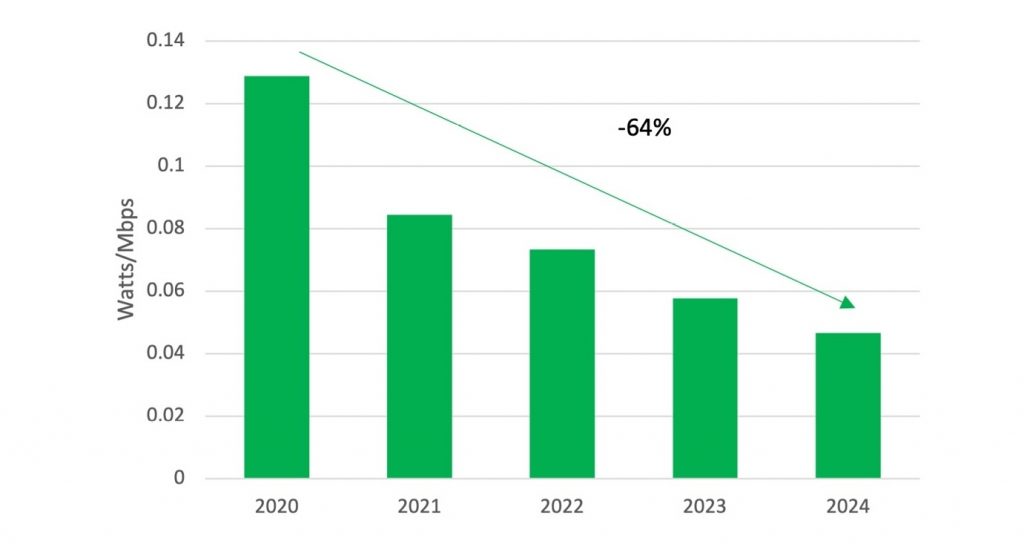
Weighted Average Energy Usage of New SNE, Relative to Broadband Download Speed
These impressive declines lower household energy use while maintaining the quality of service customers expect.
Continuing the Commitments
The signatories of these voluntary agreements are committed to continued success. Just recently, both the U.S. STB and SNE VAs extended their terms through 2028 with reports in 2029. More importantly, the SNE VA expanded the VA scope to include fixed wireless access (FWA) devices, increasing the residential market coverage by 13 million more subscribers, and added T-Mobile as a signatory.
The U.S. STB Voluntary Agreement brings together the largest pay-TV providers, manufacturers and energy efficiency advocate ACEEE (American Council for an Energy-Efficient Economy). Similarly, the SNE Voluntary Agreement includes the leading residential internet providers, major equipment manufacturers and Pacific Gas and Electric Company (PG&E) as the efficiency advocate. In Canada, CEEVA signatories include the country’s largest internet and pay-TV service providers and key manufacturers in close collaboration with Natural Resources Canada (NRCan).
CableLabs provides the technical leadership behind the voluntary agreements, working in close partnership with the Consumer Technology Association (CTA) and NCTA – The Internet & Television Association to deliver these measurable results.
Signatories
| U.S. STB VA | U.S. SNE VA | CEEVA |
| ACEEE, Altice USA, AT&T, AT&T/DIRECTV, Charter, Comcast, Cox, DISH Network, Frontier, Verizon, Sagemcom, Vantiva | Pacific Gas and Electric Company, Altice USA, AT&T, Charter, Comcast, Cox, Frontier, Verizon, Actiontec Electronics, ASUS, eero, Google, Linksys USA, Netgear, Plume, Sagemcom Broadband, TP-Link, Ubee Interactive, Vantiva | Bell Canada, Cogeco, Rogers, TELUS, Vidéotron, Echostar Technologies, Vantiva |
Why It Matters
Energy efficiency in household electronics doesn’t make headlines the way solar farms do. But the cumulative effect is enormous. Collectively, these voluntary industry agreements have prevented billions of dollars in electricity usage and eliminated hundreds of millions of metric tons of CO2 emissions. They’ve also shown that efficiency and innovation can go hand-in-hand: faster broadband, sharper video, and smarter networks don’t have to mean higher utility bills.
As we spend more time streaming, gaming, and connecting, it’s worth remembering that the invisible progress inside our routers and set-top boxes is part of the bigger climate solution. These improvements underscore how voluntary agreements can drive efficiency gains without compromising performance.
You can read more about energy efficiency on our blog and learn more about the voluntary agreements for the U.S. and Canada.
Technology Vision
Reshaping the Customer Experience With Agentic AI
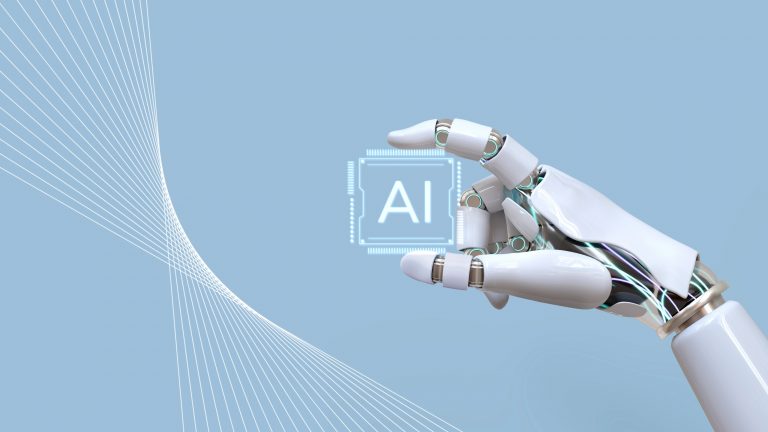
Key Points
- Agentic AI enables proactive network issue resolution, which can reduce costly truck rolls and customer support calls for broadband operators.
- Join us at SCTE TechExpo25 this week for two sessions dedicated to agentic AI and dive further into how automation can transform network operations.
Over the last year, the term agentic AI has become ubiquitous. It’s been described as everything from a personal assistant to a replacement for human workers. In reality, agentic AI is a powerful new form of automation that is most effective when given clear tasks, guided by expert information and integrated with human-in-the-loop workflows to ensure accurate and efficient automation.
In this blog post, we explain how agentic AI is revolutionizing automation by creating systems that don’t just follow pre-programmed rules but understand and adapt to their environment, make informed decisions and take autonomous action to address real-world challenges.
What Is Agentic AI?
Agentic AI is a system composed of multiple AI agents that collaborate to complete complex tasks. Key components include:
- Planner: A planner agent leverages expert information to break down complex tasks into steps that can be distributed among agents, ensuring alignment with organizational and industry best practices.
- Supervisor: A supervisor agent uses the plan identified in the previous step to coordinate work among specialist agents. It determines task completion and manages workflow.
- Specialist: Each agent has a specific role, executing steps in the plan using assigned tools and reporting back to the supervisor.
- Tool calling: Tools are executable functions that enable agents to take autonomous action by connecting AI agents to data sources and performing specific functions.
Enhancing the In-Home Experience
For broadband operators, in-home Wi-Fi issues are a leading driver of customer support calls. It’s difficult for operators to resolve these issues remotely, and sending a field technician is both time-consuming and costly.
CableLabs is developing an agentic AI system to autonomously and proactively detect and resolve in-home network issues, transforming both in-home Wi-Fi management and access network operations — and reducing the number of support calls operators receive. The key components of these systems include:
Continuous Wi-Fi KPI Streaming and Analysis
Using OpenTelemetry and OpenWRT, Wi-Fi KPIs including jitter, latency, airtime utilization and packet loss are collected in real time. Machine learning (ML) models correlate network and application-level KPIs to determine quality of experience.
Wi-Fi Impairment Detection
If degraded performance is detected, ML models identify specific impairments:
- Congestion: Too many devices or applications competing for airtime, leading to higher latency and jitter. In real-time apps like Zoom, this can cause choppy video, skipped frames, audio dropouts or lip-sync issues.
- Signal attenuation: Weak signals from distance or interference, reducing speed and reliability. Devices with a weak signal often transmit at slower speeds (lower Modulation and Coding Scheme, or MCS, rates), consuming more airtime and potentially slowing down the entire network.
- Interference: Competing signals from nearby Wi-Fi networks or non-Wi-Fi devices (like microwaves or Bluetooth) disrupt communication. In apartment or condo buildings, overlapping signals from neighbors’ routers can crowd the airwaves, reducing capacity for everyone.
- Sub-optimal channel selection: The access point remains on or switches to a channel that is already saturated or prone to interference, often due to misconfiguration or poor channel selection logic.
- Coverage gaps (possible access point placement issue): Persistent low signal strength and throughput in certain areas of the home, often caused by the access point (AP) being too far from devices or blocked by walls/furniture. While placement can’t be confirmed from Wi-Fi stats alone, patterns in signal and performance data can indicate that moving the AP may improve coverage.
- Sticky clients: Devices remain connected to a weaker AP or frequency band instead of roaming to a stronger one, causing sustained poor performance. Because the decision to roam is often controlled by the client device, it’s not always possible for the network to force the change. However, by detecting and reporting sticky client behavior, we can provide vendors and device manufacturers with the data they need to adjust roaming logic and improve performance.
Automated Resolutions
AI agents can apply QoS mechanisms automatically to restore performance or notify the user of actions they can take, such as relocating their router or adding a Wi-Fi extender or mesh node.
Detecting and Resolving Access Network Impairments
On the access network side, signal impairment detection remains a challenge, making it harder to resolve issues that degrade a user’s quality of experience. To address this, CableLabs is developing:
Robust Impairment Detection Algorithms
These algorithms analyze upstream and downstream KPIs and data for evidence of impairments. Instead of using hard-coded, deterministic algorithms, machine learning models are trained on robust datasets of upstream and downstream KPIs. Separate ML models are used for impairment detection in each direction, yielding improved accuracy compared to a combined model. This approach, when combined with data from numerous network configurations, ensures that the impairment detection process is robust across multiple operators without needing customization for each network.
Real-Time Telemetry Data Analysis
While machine learning models can be trained on infrequently collected data, the accuracy of these models improves dramatically when data are collected more frequently. Real-time or near real-time data collection produces more accurate impairment detection models and enables real-time or near real-time impairment detection. The ML models must also be lightweight enough to run at the edge to minimize data collection costs and ensure faster impairment detection by eliminating the need to send the data to a centralized location for processing.
Agentic AI Systems for Guided Impairment Resolution
The impairment detection algorithms integrate with agentic AI systems that autonomously collect the upstream and downstream KPIs and perform impairment detection. Once impairments have been identified, the agentic AI system uses expert information to provide step-by-step resolution plans for field technicians. Instead of providing static plans, the system guides field technicians through each step, pulls real-time data from their meters and updates steps based on collected data to ensure accurate and timely impairment resolution.
What Are the Challenges?
Real-Time Data Availability
The ability to obtain real-time, streaming telemetry data from devices on the network is essential to producing accurate impairment detection algorithms, without which the proposed resolutions will not succeed in resolving the quality of experience. While real-time data can be collected from devices on the network, Simple Network Management Protocol (SNMP) is usually the only option for collecting these data but it is not fast enough to support real-time data collection at the scale required for robust impairment detection. Consequently, real-time data streaming must be supported more robustly throughout the industry to enable autonomous impairment detection and quality of experience restoration.
Edge Compute Limitations
Traditionally, edge compute devices in broadband networks, especially customer premises equipment (CPE) such as cable modems and routers, have very limited compute resources. The limited compute capabilities of these devices present challenges to running inference with ML models and small language models (SLMs) on these devices. For lightweight ML models that are not based on neural networks, the compute capabilities of CPE devices are sufficient for performing inference. Some small neural networks and very small SLMs can perform inference with the compute resources on these devices, but larger neural networks and most “edge” SLMs are not capable of running on these compute resources. Additionally, the lack of access to graphic processing units (GPUs) or neural processing units (NPUs) on CPE devices further limits the feasibility of using machine learning models and SLMs for inference at the edge. This is because it results in much slower inference latency compared with GPU- and NPU-enabled models.
Edge Storage Limitations
There is an increasing number of options for SLMs that were designed to function as AI agents on edge devices. These SLMs are small enough to run in compute-limited environments and can typically be run using only CPU instead of requiring at least one GPU; however, the weights for even the smallest of these models exceed 1 GB. Therefore, in addition to requiring sufficient edge compute for low-latency AI agent responses, the edge device must also have sufficient storage to store the weights for these SLMs. While some edge devices have enough storage to hold the weights, the compute and storage capabilities of cable modems and routers are frequently insufficient for these use cases.
Data Privacy and Security
Making real-time, streaming telemetry data available to agentic AI systems at the edge enables real-time impairment detection and autonomous impairment resolution, but it also creates an attack vector and opens questions about data governance and privacy. While edge-hosted SLMs remove concerns about sending sensitive data to cloud large language model (LLM) providers, they open concerns about malicious code being embedded in the model weights and data exfiltration through model response analysis or backdoor attacks. Additionally, careful attention must be paid to how the interfaces that provide access to network data are constructed to prevent unauthorized access and unauthorized actions by the agentic AI system.
The Road Ahead
Agentic AI provides a powerful new form of automation, enabling agents to access and interpret information from their environment and external data sources, determine the appropriate course of action and autonomously take action to resolve issues within their environment.
By leveraging agentic AI at the edge, networks can become self-healing by detecting and resolving impairments autonomously and proactively addressing degradations and potential impairments before they impact subscribers’ quality of experience. In addition to acting autonomously to maintain network quality, agentic AI systems can guide field technicians through the impairment resolution process using expert information from veteran field technicians, reducing the time required to train new field technicians and drastically reducing mean time to resolution for impairments.
Find Us at TechExpo25 and Get Involved
If you’ll be at SCTE TechExpo25 next week in Washington, D.C., connect with our team to learn how your organization can contribute to shaping network automation with agentic AI. We will delve further into the technology’s capabilities during these sessions Monday, Sept. 29, and Tuesday, Sept. 30 (times are EDT):
- Agentic AI Transforming Network Operations: Join Paul Fonte and Shafi Khan for this panel discussion on how agentic AI enhances Wi-Fi, access networks and field operations — and, ultimately, the customer experience — using predictive analytics and real-time optimization. Part of the Intelligence at the Edge block, this session is 1-2:15 p.m. Monday in Room 151 AB.
- Engineering the Future: Cloud, AI and the Rise of Agentic Systems: Megan Collins joins this panel to discuss how AI and generative AI are transforming network operations to create next-generation network architectures. This session is part of Harnessing AI for Experience and Efficiency, which runs 4–5:15 p.m. Tuesday, also in 151 AB.
As AI continues to reshape network infrastructure, your voice and expertise are critical. Whether you’re an operator, vendor or software developer, we invite you to join us in shaping the future of these technologies. CableLabs offers many working groups focused on critical areas — everything from standardizing APIs to defining secure automation frameworks — where your contributions can drive real industry impact.
Events
TechExpo25 Bound? Three Ways You Can Connect With Us in Washington
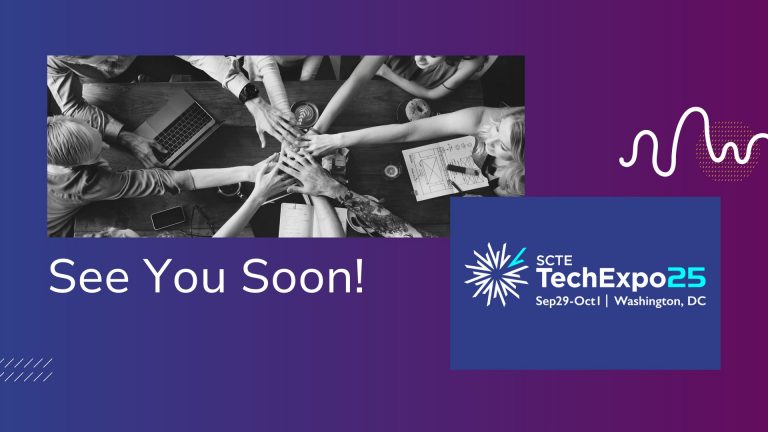
Key Points
- Each day of SCTE TechExpo25, CableLabs’ technology, policy and strategy experts will share their insights and expertise on fiber expansion, AI solutions, network convergence, customer-centric experiences and much more.
- Registration closes soon for CableLabs members-only tours of show floor exhibitors that are developing DOCSIS® 4.0 or XGS-PON technology products.
- Use this quick guide to make CableLabs engagement a priority in your TechExpo agenda.
SCTE TechExpo25 kicks off in less than a week in Washington, D.C. This year, CableLabs is going all-in to provide high-impact engagement opportunities for our member and vendor communities — from members-only sessions and guided show floor tours to live, expert-led demos showcasing the technologies that are reshaping connectivity.
If you’re already registered, this blog post is your guide to maximizing your CableLabs connections and exploring the comprehensive Technology Vision for the broadband industry. If you’re not registered yet, there’s still time — register now. (And don’t forget that employees of CableLabs member companies are eligible for complimentary full-access passes!)
Block time each day — Monday, Tuesday and Wednesday (Sept. 29–Oct. 1) — for these opportunities to go behind the scenes and dive deeper into the future of broadband. All times are EDT.
1. Live, Expert-Led Demos
Every day during show floor hours at the NCTA booth (F600)
Stop by for expert-led demos on the technologies driving the future of connectivity. Part of NCTA's experiential, policy-focused exhibit The Continuum, each demo provides direct access to our team and real-time proof of how these innovations are moving the industry forward.
- Frictionless Connectivity: Learn how Zero-Touch Onboarding automates Wi-Fi connections without apps or technical support — enabling instant, seamless and secure connections.
- Smart Networks, Seamless Experiences: Dive into Quality by Design (QbD) technology, in which apps and networks communicate automatically to fix performance issues. QbD enables smoother streaming and faster load times without any user intervention.
- Optimized Network Performance: Watch AI-powered session automation manage bandwidth across multiple devices and applications automatically. See how critical tasks like video calls maintain quality even during peak household usage.
- The Future Is Dynamic: Discover how Dynamic Spectrum Sharing (DSS) lets different technologies coexist in the same spectrum, creating abundance from scarcity and enabling seamless connectivity everywhere.
2. Members-Only Tours
Every day on the show floor
Limited spots remain for our curated tour experiences with some of the innovators behind the latest DOCSIS 4.0 or XGS-PON technology products. Some tours are already filled, but waitlists are available. Register by Thursday, Sept. 25, to join an open tour or be added to a waitlist.
- DOCSIS 4.0 Core (Tour 1): 11–11:45 a.m. Monday
- DOCSIS 4.0 CPE (Tour 2): Noon–1 p.m. Monday
- XGS-PON OLTs/ONUs (Tour 3): 10:45–11:30 a.m. Tuesday
- DOCSIS 4.0: Actives and Passives (Tour 4): 11:15 a.m.–12:10 p.m. Tuesday
- XGS-PON ONUs (Tour 5): 9:15–10 a.m. Wednesday
3. Interactive Sessions
Every day in conference rooms 146 BC, 150 AB and 151 AB
Our team is moderating panels, leading technical deep-dives and sharing the stage with industry leaders. We’ve highlighted several sessions below, and you can explore the full agenda for even more discussions on the key topics shaping the industry.
Monday
- Agentic AI Transforming Network Operations (Session block: Intelligence at the Edge) — 1-2:15 p.m., Room 151 AB
- An Automated Spectrum Analysis Framework (Session block: Analyzing, Managing and Maximizing Wireless Networks) — 1:20–2:15 p.m., Room 150 AB
- Wi-Fi Reliability (Session block: The Reliability Revolution in Wi-Fi) — 2:30–3:45 p.m., Room 150 AB
- Edge LLM Hosting (Session block: Operationalizing LLMs in the Network Ecosystem) — 4–5:15 p.m., Room 151 AB
- Emerging Fiber Technologies — How AI is Driving Innovation of Future of Transmission Networks (Session block: Speed, Intelligence and the Future of Fiber: Innovations Driving Next-Gen Transmission) — 4–5:15 p.m., Room 146 BC
Tuesday
- E.T. Phone Home: Converging Opportunities from Earth to Space (Session block: Converging Networks, Expanding Horizons) — 12:30–1:45 p.m., Room 150 AB
- Seamless Connectivity Service — CableLabs Members Only (Session block: Seamless by Design: Innovative Paths to Scalable, Always-On Networks) — 2–3:15 p.m., Room 150 AB
Wednesday
- The Transformative Impact of Coherent PON (Session block: Architecting the Future Access Platform) — 11:30 a.m.–12:45 p.m., Room 146 BC
Learn more about these sessions and exclusive opportunities in our recent blog post, plus explore the TechExpo25 agenda to discover dozens more opportunities to hear from the industry’s thought leaders across all conference tracks.
Make planning easier by downloading the TechExpo25 app from your device’s app store. For quick and easy access to these ways to connect with us, copy and paste this blog post into a new note in the app.
Ready to Join the (R)evolution?
SCTE TechExpo25 isn’t just another industry conference — it’s where the future of connectivity gets decided in real time. Join us next week to connect with the CableLabs experts who are helping lead the charge.
Can’t make it to D.C. or just want to keep your ear to the ground during the conference? Follow our coverage on LinkedIn for updates and insights.
See you soon!
Security
Hacker Summer Camp 2025 Debrief: AI and the New Threat Landscape
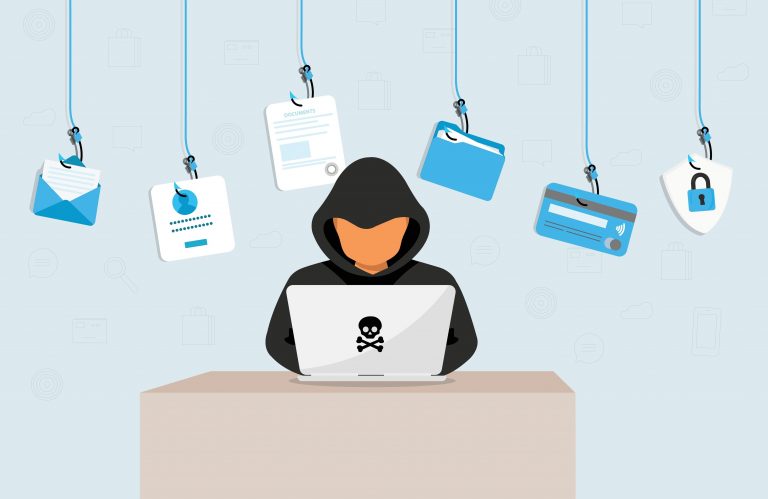
Key Points
- The annual confluence of cybersecurity conferences — known informally as Hacker Summer Camp — drew experts and practitioners from all corners of the cybersecurity ecosystem to Las Vegas in August.
- In this blog post, CableLabs highlights high-level takeaways from the Black Hat USA and DEF CON conferences — with the evolution of AI (and the security gaps arising from it) being a common theme.
- We delve deeper into our insights from the conferences in a new members-only technical brief and will explore the topics further in a CableLabs webinar on Sept. 17.
Last month’s Hacker Summer Camp brought together hackers, researchers, practitioners and leaders in cybersecurity to review the cutting edge of security research, share tools and techniques, and find out what’s at the front of everyone’s mind in the security space.
So, what was at the forefront of the conversation this year in Las Vegas, and what trends in cybersecurity do you need to be aware of?
We outline our takeaways from Black Hat USA and DEF CON in a new CableLabs technical brief, available exclusively for our member operators. We’ll also dive into the conferences further during a members-only webinar on Wednesday, Sept. 17. Members can register here to join us.
For now, some of our high-level insights are summarized here.
What’s Old Is New Again: Hacking Like It’s the 90s
With the rapid adoption of tooling like generative AI and its agentic variants, the implications of overlooking the basics in security are more impactful than ever. Many different presentations at Hacker Summer Camp focused on this theme, in which researchers consistently demonstrated how classic cyberattacks are still thriving, now applied to modern contexts like agentic AI. The takeaway? AI-centric software is still software; thus, the basics apply: applying least privilege, separation of interests, thorough input sanitization and more.
AI: Your New, Non-Deterministic, Insecure Execution Environment
Unsurprisingly, AI remains at the forefront of the discussion. Novel from recent years was the notion that AI is no longer simply a chatbot interface added to your architecture, but a whole new execution environment. Many presentations and demonstrations showcased how large language model (LLM)-powered applications and agentic AI constructions can be abused or confused, with several undesirable outcomes. While there’s a great deal of work to be done to secure emerging AI technologies, many strategies for mitigating attacks were recommended. AI is being adopted in cybersecurity too, from both the adversarial and defender perspectives, which makes it clear that another cybersecurity arms race is underway.
Automation Pitfalls: Deploy Fast, Break Faster — With a Bigger Blast Radius
Automation tooling, such as continuous integration and continuous delivery (CI/CD), took center stage for many discussions, where simple and subtle misconfigurations resulted in significant consequences, from initial access and lateral movement. With one of the killer use cases of agentic AI being coding assistants and source code reviews, today’s relationship between AI and automation tooling is a close one. The aforementioned attack surface of those AI components thus has direct implication to that of the automation tooling.
Initial Access: CI/CD, Developers and Supply Chain Attacks
Finally, the conferences this year demonstrated the increasing burden of developers to act as bastions of security. However, the attack surface faced by the average developer is also increasing. This is due in part to the addition and management of AI assistants with access to code as well as the use of plugins for Integrated Developer Environments (IDEs) like Visual Studio Code that are ubiquitous across the industry. Developers and the tools they interact with are increasingly valuable for adversaries to target, creating opportunities for initial access and even executing supply chain attacks.
Cybersecurity Evolution Continues Moving Forward
Hacker Summer Camp 2025 made it clear that the rapid shifts we’re seeing in technologies like AI have left significant gaps in ensuring that the basics of security remain covered. It also demonstrated that cybersecurity professionals and enthusiasts are doing the work required to address those gaps, as well as adopting new and adapting classic approaches to bolster cybersecurity controls.
To learn more about the content and themes covered during the conferences, download our members-only tech brief and plan to join us Wednesday, Sept. 17, for the Lessons from Hacker Summer Camp 2025 webinar.
If you’re an employee of a CableLabs member operator and don’t yet have an account, register for access to the tech brief and much more member-exclusive content.
Events
Join the Network (R)evolution With CableLabs at SCTE TechExpo25

Key Points
- SCTE TechExpo25 attendees can gain exclusive access to the industry thought leaders, breakthrough technologies and strategic insights that are reshaping how the world connects.
- CableLabs members are eligible to receive complimentary full-access passes to the event Sept. 29–Oct. 1 in Washington, D.C.
- Register today for an action-packed agenda, including countless opportunities to engage with and learn from industry experts in technology demonstrations, show floor tours and essential sessions.
The broadband industry is at an inflection point. AI-enabled networks, fiber expansion and converged connectivity are reshaping how operators compete and deliver value. The question isn’t whether transformation is coming — it’s whether you’ll lead it or follow it.
Revolutionizing the network landscape promises a future of connectivity with limitless possibilities. How can broadband operators and their suppliers thrive in the midst of the evolving landscape of wireline, wireless and converged networks? Discover how to leverage cutting-edge technologies like AI, automation and advanced networking while tackling challenges in security, operations and construction — all to deliver the seamless experiences customers crave.
Where Innovation Meets Execution
SCTE TechExpo25, the Americas’ largest broadband event, tackles the industry’s most pressing trends and challenges head-on, equipping broadband operators and their suppliers with the tools and insights to stay ahead in this transformative era.
From Monday, Sept. 29, to Wednesday, Oct. 1, in Washington, D.C., TechExpo attendees will join a community of thought leaders and experts as they dive deep into the trends and technologies reshaping broadband, including:
- Fiber expansion: Discover strategies to accelerate fiber-to-the-premises (FTTP) deployments, ensuring you lead in the race for gigabit connectivity.
- Convergence of networks: Learn how to seamlessly integrate wireless and wired networks to maximize performance and efficiency in a 5G-driven world.
- Rural broadband solutions: Uncover innovative approaches to close the digital divide and win in underserved markets with government-backed incentives.
- Customer-centric experiences: Explore how to meet rising customer expectations with better reliability, exceptional service delivery and new differentiated services.
Why Attend?
- Expert-led sessions: Learn from industry leaders who are shaping the future of broadband.
- Cutting-edge innovations: Experience live demonstrations of the latest technologies and solutions driving the broadband network (r)evolution.
- Actionable insights: Walk away with a clear roadmap to tackle your unique challenges and thrive in the competitive broadband space.
- Network with the best: Build connections with peers, partners and innovators.
In addition, employees of CableLabs member operator companies can receive complimentary full-access passes, which include all headliner and conference sessions as well as entry to the show floor and a private lounge. SCTE is a CableLabs subsidiary.
Fueling the Future of Connectivity
This year’s agenda spans seven dedicated tracks — from AI & Automation to Differentiated Services, Wireless & Convergence and StreamTech — ensuring that every attendee leaves with practical knowledge and actionable insights. The AI Zone will return, bringing live demos and cutting-edge applications to the show floor.
Featured speakers include CableLabs President and CEO Phil McKinney, CableLabs CTO Mark Bridges, SCTE President and CEO Maria Popo, and executives from CableLabs member companies:
- David Watson, Chief Executive Officer, Connectivity & Platforms, Comcast
- Frédéric Perron, President and CEO, Cogeco Inc. and Cogeco Communications Inc.
- Bin Haga, Chairman of the Board, Representative Director, J:COM
- Charlie Herrin, President, Technology & Product, Connectivity & Platforms, Comcast
- Justin Colwell, Executive Vice President, Technology Strategy & Innovation, Charter Communications
- Elad Nafshi, Executive Vice President, Chief Network Officer, Comcast
- Tom Monaghan, Executive Vice President, Field Operations, Charter Communications
- Damian Poltz, Senior Vice President, Wireline Network and PMO, Rogers Communications
- JR Walden, CTO & SVP, Mediacom Communications
Connect With CableLabs at SCTE TechExpo25
If you’re making TechExpo25 plans, reserve time in your schedule to engage with CableLabs experts in behind-the-scenes explorations of the technologies and companies forging the future of the broadband industry. In addition to providing their perspectives in nearly two dozen engaging sessions, our team will be on hand to bring you live, interactive demonstrations and guided tours that bring the latest broadband innovations to life.
Join us for the demos, tours and sessions below to explore our comprehensive Technology Vision for the future of connectivity, and discover how these breakthroughs are transforming everything from spectrum sharing approaches to seamless user experiences.
Expert-Led Demos Powered by CableLabs
Monday through Wednesday during show floor hours, visit the NCTA booth (F600) for hands-on demonstrations with CableLabs experts. Each demo offers a unique opportunity to engage directly with our team and see firsthand how these technologies can address real-world challenges in our industry.
The demos include:
- Frictionless Connectivity: Explore Zero-Touch Onboarding, which can automate Wi-Fi connections for health care devices without apps or technical support. See how users — such as patients and caregivers — can benefit from instant, seamless and secure connectivity for remote monitoring and virtual visits.
- Smart Networks, Seamless Experiences: Dive into Quality by Design technology, where apps and networks can communicate automatically to resolve performance issues. Experience how this delivers smoother streaming and faster load times without user intervention.
- Optimized Network Performance: Session automation gets the spotlight in this AI-powered network optimization demo showing automatic bandwidth management for multiple devices and applications. Watch how critical tasks like video calls maintain quality even during peak household usage.
- The Future Is Dynamic: Dynamic spectrum sharing (DSS) technologies can transform how operators deploy networks by allowing different technologies and use cases to coexist in the same spectrum. This presentation will explore how DSS can create abundance out of scarcity — enabling seamless and reliable connectivity for consumers no matter where they are.
Member-Only Vendor Tours
Exclusive to CableLabs member operators, we are also offering a series of five curated tour experiences on the TechExpo show floor. Members can register for one of the five tours, each featuring companies that are developing DOCSIS 4.0 or XGS-PON technology products.
- DOCSIS 4.0 Core (Tour 1): 11–11:45 a.m. Monday
- DOCSIS 4.0 CPE (Tour 2): Noon–1 p.m. Monday
- XGS-PON OLTs/ONUs (Tour 3): 10:45–11:30 a.m. Tuesday
- DOCSIS 4.0: Actives and Passives (Tour 4): 11:15 a.m.–12:10 p.m. Tuesday
- XGS-PON ONUs (Tour 5): 9:15–10 a.m. Wednesday
At each stop, members will have opportunities to:
- Engage with product experts who have successfully participated in recent CableLabs Interop·Labs events.
- Get an inside look at the latest innovations driving multi-gigabit, low-latency and highly reliable broadband.
- Get a jump on understanding future solutions and start building your own views of these important technology solution areas.
If you’re a CableLabs member attending TechExpo, view the tour topics and find a time that works with your schedule. Spots are limited, so register for a tour by Thursday, Sept. 25.
Focused, Expert-Led Sessions
The action-packed TechExpo agenda features numerous sessions with CableLabs experts serving as moderators or panel members, including:
Monday
- Agentic AI Transforming Network Operations (Session block: Intelligence at the Edge, 1-2:15 p.m., Room 151 AB) — See how agentic AI is revolutionizing network operations across Wi-Fi, access networks and field operations through predictive analytics and real-time optimization. Paul Fonte, director of the Future Infrastructure Group at CableLabs, leads a panel discussion on AI-driven solutions that boost customer experience through predictive maintenance, remote diagnostics and guided repairs.
- An Automated Spectrum Analysis Framework (Session block: Analyzing, Managing and Maximizing Wireless Networks, 1:20–2:15 p.m., Room 150 AB) — Explore a comprehensive end-to-end framework for real-time dynamic spectrum sharing across multiple technologies and use cases to ensure regulatory compliance and interference mitigation. Robust spectrum analysis systems provide critical insights into spectrum usage and enable dynamic spectrum sharing capabilities. Mark Poletti, Roy Sun and Rahil Gandotra from CableLabs’ Wireless Technologies team discuss the latest technology trends and activities around DSS.
- Wi-Fi Reliability (Session block: The Reliability Revolution in Wi-Fi, 2:30–3:45 p.m., Room 150 AB) — This session, moderated by CableLabs principal architect Josh Redmore, dives into the growing complexity of managed Wi-Fi networks, from capacity planning and traffic modeling to translating lab testing into real-world performance gains. Join us as we explore cutting-edge approaches to Wi-Fi diagnostics, congestion management and the latest advancements in Wi-Fi standards.
- Edge LLM Hosting (Session block: Operationalizing LLMs in the Network Ecosystem, 4–5:15 p.m. ET, Room 151 AB) — Find out how to host large language models using edge compute infrastructure and integrate them into generative AI systems for industry-specific applications. The session covers reinforcement learning techniques and fine-tuning strategies that customize models for low-latency, agentic AI use cases. Distinguished technologist Randy Levensalor presents this technical paper.
- Emerging Fiber Technologies — How AI is Driving Innovation of Future of Transmission Networks (Session block: Speed, Intelligence and the Future of Fiber: Innovations Driving Next-Gen Transmission, 4–5:15 p.m. ET, Room 146 BC) — This panel looks at next-generation fiber innovations designed to meet generative AI’s demanding requirements for reduced latency and increased reliability. The discussion covers complementary technologies like Distributed Acoustic Sensing and high-density connectivity that accelerate repair speeds and enhance network scalability. Dr. Alberto Campos, CableLabs fellow, joins this panel.
Tuesday
- E.T. Phone Home: Converging Opportunities from Earth to Space (Session block: Converging Networks, Expanding Horizons, 12:30–1:45 p.m. ET, Room 150 AB) — See how cable and satellite operators are working together to create converged network services that expand coverage and enhance customer connectivity. The session examines real-world partnership results between major MSOs and satellite providers and looks at how satellite capabilities fit into hybrid network strategies. CableLabs Vice President of Technology Strategy Chris Stengrim moderates this session, and principal strategist Hans Geerdes joins as a panelist.
- Seamless Connectivity Service (SCS) — CableLabs Members Only (Session block: Seamless by Design: Innovative Paths to Scalable, Always-On Networks, 2–3:15 p.m., Room 150 AB) — This exclusive, members-only session covers the future of always-on connectivity using wired, wireless and satellite networks that work together seamlessly regardless of access technology. SCS simplifies user experience while identifying the competitive advantages, architectural requirements and use cases operators need to bring this service model to market. CableLabs’ David Debrecht, vice president of Wireless Technologies, and Sanjay Patel, senior director of Technology Strategy, share their perspectives.
Wednesday
- The Transformative Impact of Coherent PON (Session block: Architecting the Future Access Platform, 11:30 a.m.–12:45 p.m., Room 146 BC) — Distinguished technologist Matt Schmitt moderates this session on how coherent PON technology enables revolutionary new architectures and advanced services that go beyond traditional point-to-point connections. The discussion covers the strategic reasoning behind key technical decisions in transmission convergence and physical media dependent layer specifications, plus how these advancements unlock new possibilities for scalability and service innovation.
Discover many more game-changing technology topics across all tracks and expert speakers.
Are You Ready for the (R)evolution?
TechExpo gives you hundreds of opportunities to explore groundbreaking solutions, forge strategic partnerships, stay current on policy developments and transform your operations to meet the demands for seamless experiences.
Register for TechExpo25 today to connect with global operators, policymakers, vendors and innovators next month in Washington, D.C., and join the conversations shaping the industry’s future.
Innovation
Celebrating A Legacy of Transformative Leadership as NCTA’s Michael Powell Signs Off
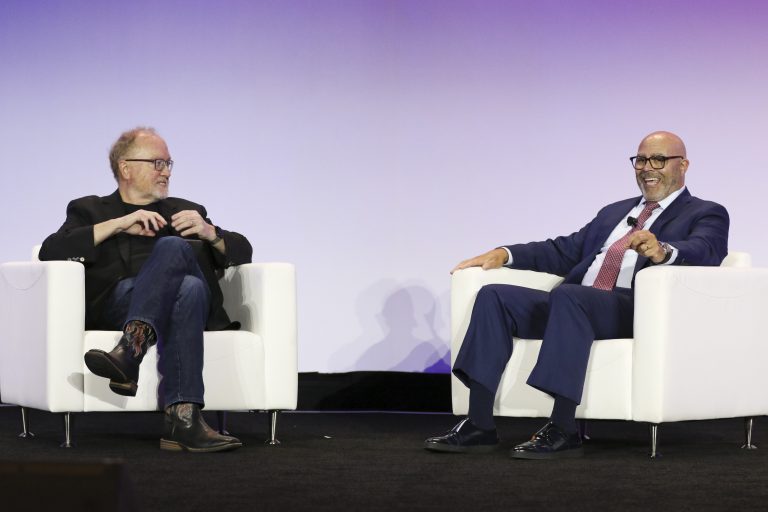
Key Points
- Michael Powell, president and CEO of NCTA, is regarded as a champion of the broadband industry whose forward-thinking approach to connectivity transcends traditional broadband infrastructure boundaries.
- Powell, who previously served as chairman of the Federal Communications Commission, has successfully advocated for spectrum sharing solutions — helping narrow the digital divide for Americans.
The broadband industry is preparing to bid farewell to one of its most influential leaders. Michael Powell's retirement from NCTA – The Internet and Television Association caps a distinguished tenure marked by revolutionary policy innovation and unwavering commitment to increasing access and advancing connectivity for all Americans — a transformative chapter that paves the way for continued progress.
As the former chairman of the Federal Communications Commission (FCC), Michael brought a unique perspective to policy shifts in the industry. Over the past 15 years as president and CEO of NCTA, he has advocated for policies that support innovation, helping to shape the future of connectivity.
Michael announced his retirement in February. This week, NCTA announced the appointment of his successor, former U.S. Sen. Cory Gardner, who represented Colorado in the Senate from 2015 to 2021 and in the U.S. House from 2011 to 2015. He will officially join the association later this month.
Champion of Broadband Access and Innovation
Michael has been called a champion of the industry by many, but his vision for the future of connectivity extends far beyond traditional broadband infrastructure.
He has been a steadfast industry ally throughout his career, first as FCC chairman, fighting battles over Title II broadband regulations, and later as president and CEO of NCTA, where he has led some of the most significant efforts toward seamless connectivity through the 10G initiative.
Michael’s advocacy for the 10G initiative — which enables widespread seamless connectivity and enables technologies that will fundamentally change how we live, work, learn and play — exemplifies his commitment to pushing the boundaries of what's possible in broadband technology. Advocating for improved speed, access and reliability for all, Michael has described 10G as “not the picture, (but the) canvas on which the demands of our imagination will be built,” underscoring the massive opportunities for innovation such a network can offer.
His ability to recognize future connectivity needs and champion the policies to make them reality has been invaluable. When the COVID-19 pandemic accelerated the need for reliable, secure and fast connectivity, the broadband industry showed it was not only ready but performed exceptionally well. Michael’s efforts and contributions to the 10G initiative helped move us forward into the connectivity that we know today and set the stage for the innovations that will drive our future.
His work with the initiative is foundational to the Technology Vision for the future of the industry, the next generation of connectivity innovation.
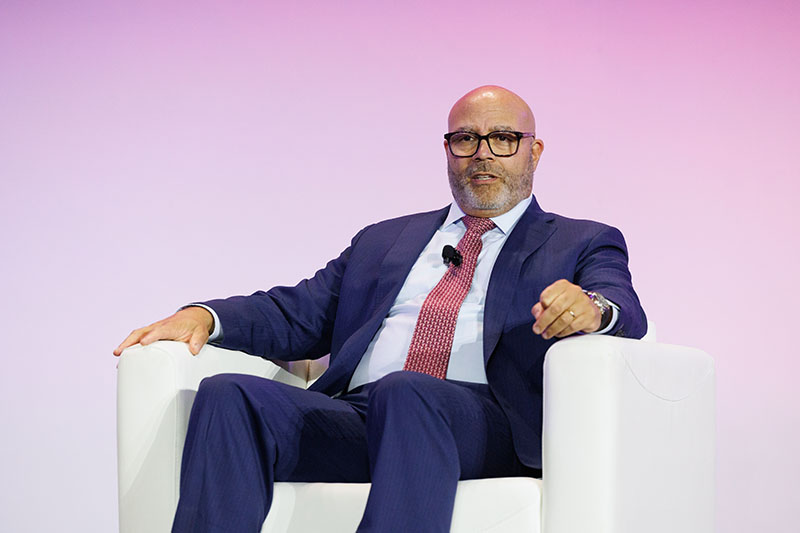
Above and at top: Michael Powell speaks with CableLabs President and CEO Phil McKinney during a general session at SCTE TechExpo in 2023.
Spectrum Leadership and Wi-Fi Advocacy
Michael’s tireless advocacy for unlicensed spectrum and innovative solutions to unlock these wireless resources has been instrumental in shaping the industry's future. His support for spectrum sharing solutions like Citizens Broadband Radio Service (CBRS) has increased access to critical spectrum resources, enabling additional mobile capacity to enhance consumer choice in mobile services while extending high-speed internet access to Americans in rural and underserved areas.
Earlier this year, Michael testified before the House Energy & Commerce Committee, advocating for a more comprehensive approach to spectrum management and emphasizing its essential role in maintaining America's economic and technological leadership. He argued that efficient spectrum use is fundamental to the country's competitive advantage in the global marketplace.
Michael’s advocacy stems from his conviction that “Wi-Fi is more than just convenience — it's a game-changer for our economy and innovation.”
The CableLabs Connection
For many years, Michael has served as a non-voting member of the board of directors at CableLabs. Michael’s policy work and vision for "permissionless innovation" — the idea that individuals and companies should be able to experiment and innovate with new technologies without extensive regulatory barriers — is a philosophy that has guided much of his work and helped create an environment where breakthrough technologies can flourish.
CableLabs President and CEO Phil McKinney reflects on Michael’s impact:
"We at CableLabs are immensely grateful for Michael’s leadership and advocacy. He has certainly contributed to our ability to innovate and build the networks of the future.
"He has been a guiding light on policy in the broadband industry and has brought us to where we are today. Michael has an uncanny ability to balance competing interests, promote innovation and navigate complex government and policy issues.
"The foundations he has laid will continue to benefit all of us for years to come. We’re all stronger, more innovative and better positioned for the future because of his efforts.”
Michael — who was inducted into the Broadcasting & Cable Hall of Fame in 2016 and the Cable Hall of Fame in 2022 — leaves a legacy of impact that will continue to position America as an economic and technology leader far into the future. CableLabs is grateful for his efforts and wishes him success and happiness in his well-deserved retirement.
Innovation
CableLabs Deepens Engagement With RDK-B to Accelerate Innovation

Key Points
- CableLabs’ collaboration with the RDK-B community help accelerate the path from standards to deployment for the open-source broadband platform.
- Our first major upstream contribution to the platform is the open-source implementation of Wi-Fi Easy Connect — also known as the Device Provisioning Protocol — which brings Zero-Touch Onboarding to broadband gateways.
CableLabs engineers and technologists are actively contributing to the Reference Design Kit for Broadband (RDK-B), an open-source software platform deployed by many CableLabs member companies to power connected home experiences. RDK-B forms the foundation for key residential gateway features, including set-top box (STB) integration, IoT device management and managed Wi-Fi in both single-family homes and multi-dwelling units (MDUs).
As a vendor-neutral, open-source software stack, RDK-B offers operators flexibility, transparency and control over their broadband infrastructure — values that align closely with CableLabs’ mission to drive interoperable innovation at scale.
Elevating Mesh Networking with EasyMesh
In 2024, the RDK-B community launched a major initiative to integrate support for Wi-Fi Alliance’s Wi-Fi CERTIFIED EasyMesh™ standard — prompting CableLabs to get directly involved. As longstanding contributors to the Wi-Fi EasyMesh specification, CableLabs is uniquely positioned to enhance RDK-B’s implementation and help ensure seamless, vendor-agnostic mesh networking experiences for operators and their subscribers.
Wi-Fi EasyMesh represents a significant evolution in home networking. Unlike proprietary mesh solutions, Wi-Fi EasyMesh is an open standard, enabling multi-vendor interoperability among access points, extenders and controllers. This is particularly important for operators looking to break free from vertically integrated, locked-in ecosystems that limit flexibility and slow innovation.
By standardizing mesh behavior — including topology formation, channel management and band steering — Wi-Fi EasyMesh gives operators a common framework to manage and optimize Wi-Fi networks across diverse hardware. It also opens the door for competitive procurement, reduced vendor dependency and consistent user experiences across device brands and firmware versions.
Advancing Wi-Fi Easy Connect and Seamless Onboarding
CableLabs’ first major upstream contribution to RDK-B was the industry’s first fully open-source implementation of the Wi-Fi Alliance’s Wi-Fi CERTIFIED Easy Connect™ protocol, also known as the Device Provisioning Protocol (DPP). This milestone brings support for Zero-Touch Onboarding (ZTO) to RDK-B, enabling secure, user-friendly network enrollment via QR code — without requiring users to know or input Wi-Fi credentials.
DPP is particularly well-suited to modern mesh deployments, where adding new devices (e.g., access points, IoT endpoints, controllers) needs to be fast, secure and reliable. With Wi-Fi Easy Connect now part of the RDK-B Wi-Fi EasyMesh stack, operators can deliver a smoother out-of-the-box experience for end users while enhancing network security through modern cryptographic provisioning methods. Again, CableLabs is uniquely positioned to contribute Wi-Fi Easy Connect functionality due to our continuing leadership and contributions to the specification during its development in Wi-Fi Alliance.
CableLabs publicly showcased the integration at RDK Summit 2025 in London, where I gave a featured technical talk highlighting the importance of seamless and secure onboarding in connected home environments. Simultaneously, my colleague Ben Carlson hosted a live demonstration booth, offering hands-on insight into CableLabs’ open-source contributions and their impact on RDK-B’s capabilities.
Strategic Synergy Between CableLabs and RDK-B
The collaboration between CableLabs and the RDK-B community represents a natural synergy. Both ecosystems are built around the values of interoperability, openness and scalable innovation. RDK-B provides a robust deployment vehicle, and CableLabs brings a deep well of standards leadership, cross-industry coordination and forward-looking technology development.
By contributing directly to RDK-B, CableLabs can help ensure that its latest innovations — many of which are defined in collaboration with operators, original equipment manufacturers (OEMs) and global standards bodies — are production-ready and deployable across member networks. The result is a faster path from spec to field deployment, enabling member companies to move with greater agility and confidence.
RDK-B also benefits from CableLabs’ neutrality and long-term vision. Our work with Wi-Fi EasyMesh, Wi-Fi Easy Connect and the broader Wi-Fi ecosystem is guided by industry consensus and technical rigor, helping RDK-B implementations remain future-proof and aligned with operator priorities.
RDK-B as a Strategic Distribution Platform
Because RDK-B serves as the networking software platform for many CableLabs members, it offers a compelling vehicle for delivering and scaling future innovations across the broadband ecosystem. Beyond Wi-Fi EasyMesh and Wi-Fi Easy Connect, CableLabs is actively exploring opportunities to leverage RDK-B for deployment of:
- Low Latency, Low Loss, Scalable Throughput (L4S)
- Wi-Fi CERTIFIED Data Elements™ for advanced telemetry
- Enhanced security and diagnostics capabilities
- Multi-access and hybrid access techniques
- Additional next-generation technologies in development
By aligning closely with the RDK-B community and contributing robust, standards-based enhancements, CableLabs is helping ensure that our members have access to a secure, flexible and future-ready broadband platform — one that evolves in tandem with the needs of modern connected households.
Together, RDK-B and CableLabs are building the foundation for the next generation of broadband. If you use the RDK-B platform, be on the lookout for these and other new features.



